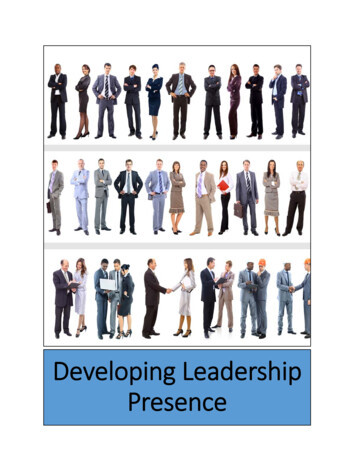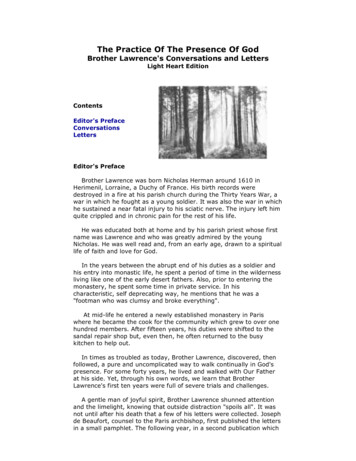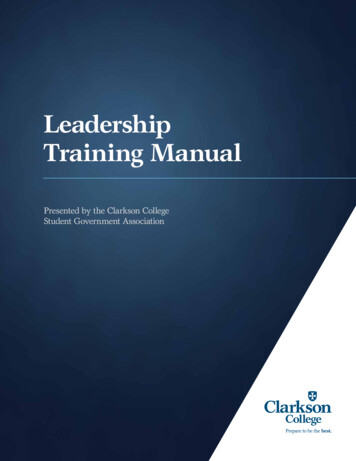
Transcription
Developing LeadershipPresence
Copyright 2015 Success Productions, LLC.ALL RIGHTS RESERVEDNo part of this publication may be reproduced or transmitted in any form or by any means,electronic or mechanical, including photography, recording, or any information storage andretrieval system now known or to be invented without permission in writing from SuccessProductions, LLC, except by a reviewer who wishes to quote brief passages in connection with areview written for inclusion in a magazine, newspaper, or broadcast. Violation is a federal crime,punishable by fine and/or imprisonment. Title 17, U.S.C., Section 104.Leadership Resources, LLC.8535 Executive Woods Drive, Suite 300Lincoln, NE 68512Published in the U.S.A.Developing Leadership PresenceFirst Edition, June 2015
Table of ContentsAbout the Authors . iiiAbout Leadership Resources . vLesson One: Leadership Presence . 1Lasting Impressions . 2Mirror, Mirror . 3A Case for Presence . 5Definition One . 5Definition Two. 5Definition Three . 7Presence Myths . 7Myth #1: Innate Presence . 7Myth #2: Canned Presence . 7Myth #3: Static Presence . 8Leadership Presence, Unveiled . 8Application and Action . 11Structured Reflection . 12Lesson Two: Sophisticated Style . 13Grooming . 13Dress . 15Minimize Distractions . 16Fit the Occasion . 16Invest in Essentials . 20Accessorize Tastefully . 21Be Modest . 22Environment . 24Wellness. 25Application and Action . 28Structured Reflection . 29Lesson Three: Etiquette Essentials . 30Manners . 30Dining . 36Host . 37Guest . 37Networking . 39Operational . 40Personal . 40Strategic . 40i Page
E‐professionalism . 42Application and Action . 45Structured Reflection . 46Lesson Four: Effective Communication . 47Assumptions . 48Message Construction . 52Verbal Delivery . 54Voice Mechanics . 54Language Considerations. 57Nonverbal Language . 58Did You Know? . 60Listening . 61Application and Action . 64Structured Reflection . 65Lesson Five: Genuine Gravitas . 66Leadership Reputation . 66Signature Voice . 68Composure . 71Emotional Intelligence . 71Inward Reflection . 72Competence . 75Capabilities . 76Results . 77Application and Action . 80Structured Reflection . 81Lesson Six: Credible Character . 82Character . 82Integrity . 84Internal Congruence . 85External Congruence . 86Compartmentalization . 88Intent . 89Candor . 89Accountability . 90Crafting a Leadership Presence Action Plan . 91Application and Action . 94Structured Reflection . 95REFERENCES. 96Appendix . 100ii P a g e
About the AuthorsBoyd Ober, President and CEOBoyd Ober’s desire to help others achieve success inspired him to found Leadership Resourcesand continues to fuel his passion today. Serving as president of the company, he devotes histime to providing organizations vision, coaching and consulting with clients, and strengtheningthe Leadership Resources team. His guidance and direction have enabled the company toexperience steady growth since it began in 2002. His objective is to empower leaders toestablish a practical plan for their own success and achieve out of life what they most desirewhile maintaining a balanced perspective.With a master’s degree in economics from South Dakota State University, Boyd Ober offersclients a unique perspective from a number of experiences, ranging from business ownership toroles in government and corporate settings. As an entrepreneur and community advocate, heunderstands the challenge of balancing business with many other areas of life. Gifted in helpingleaders establish vision for themselves as well as their organizations, Boyd combines poignantquestions with active listening to help clients clarify strategy, adjust behavior, and make adifference in the world around them. Boyd is deeply devoted to his clients and employees,bringing passion, humor, and extensive knowledge to the development process.He resides in Lincoln, Nebraska, with his wife of over twenty‐five years and three children.Dan Sedor, Executive Vice President Implementation TeamDan Sedor’s devotion to professional development as a partner, coach, and facilitator is built onyears of experience in the world of business and community involvement. Within theorganization, Dan is responsible for directing the efforts of the implementation team, includingstrategic planning facilitation, program facilitation, coaching, and organizational accountability.His background includes 25 years in areas such as sales management, human resources, andengineering positions. Having worked for three international corporations, Dan has personallytrained and presented to over 10,000 business professionals and holds coaching certificationsfrom both Fowler Wainright International and 8 to Great coaching organizations. Dan’sexperience as a facilitator and coach at Leadership Resources, coupled with his years as a coachof youth sports, motivated him to write his first book titled, MODEL Coach: A Common SenseGuide for Coaches of Youth Sports, published in 2008.Dan Sedor is a people engineer and a master of productivity. An industrial engineering graduatefrom Iowa State University and an avid observer, Dan dives into the details, helping leadersachieve success through slight edge improvements. His passion for development is contagious,as he believes each day is an opportunity to learn something new.He and his wife of 31 years have two children and live in Lincoln, Nebraska.iii P a g e
Joy Martin, Ph.D., Facilitator Coach Content WriterA developmentalist at heart, Joy Martin brings passions for supporting people and nurturingprogress to Leadership Resources’ innovative culture. Her previous professional experiences asan educator and researcher fuel her current responsibilities as a content writer, facilitator, andcoach, through which she embraces opportunities to foster connections within and betweenpeople.Joy has taught hundreds of students, ranging in age (middle school, high school, traditionalcollege learners, and nontraditional adult learners), course level (developmental, undergraduate,graduate, and doctorate), and topic (speech, writing, business communications, pedagogy,literacy, ethics, and research). As well, she recently completed her Ph.D. after studying thethought processes English teachers undergo as they read, consider, and respond to studentwriting. These vast experiences have given her an insightful and valuable perspective on how tomotivate, lead, and connect with clients as they strive for their next level of success. Joycontinues to teach as an adjunct instructor in the Doctorate of Educational Leadership programat College of Saint Mary in Nebraska and the Department of Leadership Studies at Fort HaysState University in Kansas.She lives near Lincoln, Nebraska, with her husband of 19 years and their three children.HOW TO GET THE MOST FROM DEVELOPING LEADERSHIP PRESENCEDeveloping Leadership Presence is designed to help you cultivate an effective and authenticleadership presence for the sake of leading yourself and others better. Utilizing the tips belowwill maximize your engagement with the content and improve your ability to apply the concepts,gaining greater results. The lesson exercises built within the lessons provide an opportunity to apply concepts ina personal manner.The action steps within the lessons cause you to pause and immediately reflect upon theimpact of an idea or concept in your personal and professional leadership.The Application and Action questions at the end of each lesson allow you to reflect deeplyupon the ideas in light of your personal circumstances and behaviors.The Structured Reflection activities following the Application and Action questions willsupport your insights and focus your key takeaways while engaged in the forumdiscussions.The CDs complement your reading of the content and encourage spaced repetition,which leads to deeper internalization.Set goals for reaching new levels of success while participating in this forum. All facets of theprocess—the content, content exercises, goal‐setting tools, coaching sessions, mentoringsessions, group discussions—support you getting the best possible results for you and those youlead.iv P a g e
About Leadership ResourcesWho We HelpLeadership Resources is the trusted advisor of growth companies, aligning business strategy withemerging leadership development and creating successful plans for individuals and organizationsalike.Who We AreWe are a leadership development company that identifies emerging leaders, aligns personalgoals with corporate vision, and develops leaders within organizations for future impact thatdrives results and increases cultural fit.What We Believe Honesty and Integrityo Through our respect for others we enter into and maintain business relationships thatare mutually beneficial and built on a foundation of trust. Passion to Make a Differenceo Our fundamental passion is to make a positive impact on the lives of others and ourcommunities. Commitment to Excellenceo We seek to understand what matters most to our clients and deliver tailored processesto accomplish their objectives. Green and Growingo Inherently, no person or organization is perfect – There is always room for improvement.It’s not about perfection; it’s about progress. Talento It is imperative to recognize and develop the gifts of others while doing the same forourselves. Balanced Lifestyleo We are a product of our process and enthusiastically seek to live a balanced lifestyle bypracticing the leadership principles we endorse. ProfitoProfit is fundamental to operating a successful business in which we maintain respectedcommunity and client relationships while providing for our families. Successo Success for our clients and us is the progressive realization of worthwhile, predeterminedpersonal goals.v Page
DEVELOPING LEADERSHIP PRESENCELesson One: Leadership PresenceNot everything that glitters is gold.And not everything that flashes endures.Make no mistake about it. Glitter and flash certainly appeal. They catch the eye and drawattention. They promise delight and fascinate the imagination with mesmerizing charm. Butsomething more substantial is needed for lastingabsorption—something beneath the sparkle and shine.Take gold, for instance.Along with its distinctive sunshine glow, this preciousmetal is known all over the world for its purity, itsdensity, its malleability, and its stability in value overtime. Its legacy alone deems it a trustworthy, genuinetreasure, and counterfeits ridiculously fail to compare to this coveted, one‐of‐a‐kind metal. Thegold standard has surpassed the fleeting allure of many a gem.People, too, can enthrall and dazzle. With wit and grace or poise and aura, they can captivateand transport, inspire and convince; their movements and persona influence those around them.Thoughtful leaders recognize and capitalize upon this reality in acquiring a pleasing style of theirown.But not all lasting impressions are golden. After the glitter corrodes and the flash fades, a personwith little substance disappoints and disillusions. And no wonder. While the exterior matters, italone is not enough. Developing the gold standard of leadership presence requires us to developthe “leader within” (Crittenden, 2013, para. 10). So how do leaders cast a memorable leadershippresence—universally respected and authentically executed—a presence of purity, density,malleability, and stability over time, bringing value toothers? How do they develop a leadership presence that“[Leadership] presence is anot only pleases but satisfies? They do so by developing akey factor in a leader’sgroup of skill sets that collectively project the essence ofsuccess. It helps others takeyou: your leadership presence.you seriously, identifyopportunities for you, believeYour journey of cultivating an authentic leadership presencewhat you say, and trust youstarts in this lesson by exploring the nature of presence, theto make good decisions Youprimary skill sets involved, and some fundamentalmust look and act the part”professional principles to prepare you to fashion your(Crittenden, 2013, para. 12).leadership best—working from the outside in.1 PageCopyright 2015 Success Productions, LLC
LASTING IMPRESSIONSNo question about it. Making a strong first impression is essential to professional successbecause a striking impact is memorable. This first “imprint” of you remains in others’ minds,making the first encounter a potential base fromwhich all future interactions and opportunitiesstem. But as the cliché goes, you only get onechance to make a good first impression to showthe level of impactful‐ness you could have uponothers.Just how long does it take for an impression to beformed? Half a minute? Seven seconds? Evenless. Researchers at Princeton found that in as fewas 100 milliseconds (.1 of a second), people makejudgments on specific personality traits in other people when looking at their faces (Willis &Todorov, 2006). Even more astonishing, neurocognition research recently revealed that split‐second time is all it takes to form a judgment based on voice alone. Within 500 milliseconds, orhalf a second, listeners form a judgment on certain personality traits merely by hearing a “hello”(McAleer, 2014, para. 1). Imagine how many judgments are made on you before you’ve evenintroduced your name!And yet, as strong as they are, first impressions are not guaranteed to be lasting. After all, rashjudgment may not lead to correct conclusions. Granted, these judgments you make of others’characteristics affect how and with whom you socially interact (McAleer, Todorov, & Belin,2014), but leadership presence is built upon much more than momentary encounters.Impressions you gather over time lead to an evaluation of a leader’s enduring presence (Dagley& Gaskin, 2014). It is what you do over time that contributes to others’ lasting impression ofyou.Do you find yourself making quick judgments of others based on first impressions? Explain.Describe a time your first impression of another has been accurate.Describe a time your first impression of another has been inaccurate.2 PageCopyright 2015 Success Productions, LLC
MIRROR, MIRRORSo given that leadership presence includes first impressions, leaders should take a look in theproverbial mirror. Most people don’t find scrutinizing what they see in the mirror as apleasurable activity. But when it comes to developing your leadership presence, image‐checkingtakes on a whole new level; knowing what to develop requires a reasonable awareness of theimage you project.Let’s move deeper into this lesson by exploring some elements of presence. For each item in thetable below, consider what you see and what you assume others see in you. These insights cangive you a fresh, “eye‐opening” perspective now and a valuable, long‐range perspective later.PRESENCE PERSPECTIVEFor each aspect on the left, rate your current satisfaction level on a scale of 1‐5 with 1 being verylow and 5 being very high. You can use the notes column to jot down insights on ratings ofspecial interest to you. Be honest—without overthinking.ASPECTSSATISFACTION RATINGNOTESmy physical stature12345my dress, grooming, accessories12345my manners12345my conversational skills12345my attitude12345my personality12345my warmth123453 PageCopyright 2015 Success Productions, LLC
ASPECTSSATISFACTION RATINGNOTESmy verbal skills12345my listening skills12345my body language12345my energy12345my composure12345my confidence12345my reputation12345my courage12345my honesty12345my thoughtfulness12345my consistency12345my genuineness12345my trustworthiness123454 PageCopyright 2015 Success Productions, LLC
A CASE FOR PRESENCEAs Glinda, the good witch of the West in the Wizard of Oz, suggested, the best place to begin isthe beginning. So as you launch into this study, let’s start with the definition of presence.pres ence \ 'prez‐ͣn(t)s\ n1. something or someone that is seen or noticed2. fact or condition of being in a particular place3. the bearing, carriage, or air of a personDEFINITION ONEKnow this, leader: People watch you. They watch what you do, what you say, what you wear,where you go. They see how you treat others, how you treat yourself, what you avoid, what youpursue. What you knowingly or unknowingly project through your words and behaviors, then,speaks volumes about who you are and what you value.People also pay attention to how you make them feel. They notice when you see them andwhen you don’t. They remember the promises you keep and those you forget. They endureyour sarcasm and uncertainty. And they sense when you genuinely care and when you put on agood face.Leadership presence in rudimentary form means taking stock of the fact that you are visible.DEFINITION TWOAdditionally, people want you to be present, to be there, with them—mentally and emotionally.They desire your wisdom and insight, seek to draw upon yourexpertise and humanness, to tap into your well of strength and“People who give us theircourage. And serving others as a leader requires your physicalundivided attention mostpresence—to simply attend to others in the moment in a way thatvividly manifest presence”demands putting everything else on hold.(Helgesen, 2014, para. 4).Likeable leaders don’t crave attention (Bradberry, 2015); theygive it. Their focus respectfully moves toward the person or task before them. By suspendingjudgment and bias and bracketing out useless thoughts, they open up the capacity to see andhear and think, freely and courteously. They support the basic human need of being known andbeing loved (Scott, 2004); being present, being with and accessible to others, is an efficaciousway of connecting. Yet being present in the moment is easier said than done. Through theirwork with actors, Halpern and Lubar (2003, pp. 41‐48) identified three general guidelines tostrengthen attentive leadership presence: focusing on the physical, changing your perspective,and letting thoughts go and feelings be.5 PageCopyright 2015 Success Productions, LLC
BEING PRESENT IN THE MOMENTGuideline #1:Focus on the Physical Guideline #2:Change Your Perspective Guideline #3:Let Thoughts Go; Let Feelings Be How are you doing withGive full attention.o Stop what you’re doing. being present physically?o Face the person.o Smile. The person isthere for a reason.Be in the body.o Sit in a comfortable,alert position.o Relax your muscles.o Sense your body fullyalive.Breathe deeply.Transform your inner critic. How are you doing withyour mental attitude ino Pay attention to yourthe moment?self‐talk.o Accept that you are notperfect.o Focus on the intentionof your goal.Recognize others’ dignity.o Accept that others arenot perfect.o Focus on others’ needs.Pay attention to what youare feeling.Allow yourself to briefly sitwith an emotion, lettingthoughts go.Separate the emotion fromthe person.See emotions as indicators,not dictators.How are you doing withbeing presentemotionally?Adapted from Halpern & Lubar (2003). Dramatic techniques to reach out, motivate, and inspire leadership presence. New York, NY: Gotham Books.6 PageCopyright 2015 Success Productions, LLC
DEFINITION THREEDefinition three—presence as the bearing, carriage, or air of a person—is the most robust andvisual of all three meanings. It is the outcome of all you think, say, and do and the means bywhich others will perceive you. But the aura you present is not a matter of chance; rather, it ischiefly under your control. The following lessons will probe deeply into this essence you canshape.Much of the success you enjoy as a leader depends upon the presence you display. Action Step: Take a moment to reflect upon the definitions of presence. Whatnew insight have you gained about yourself and your presence?NOTES:PRESENCE MYTHSA lot of variability exists regarding the nature of leadership presence. To clear up someconfusion, let’s first rule out what presence is not.MYTH #1: INNATE PRESENCESome people think certain lucky people are born with leadership presence. Wrong! Leadershippresence is a set of skills anyone can develop. Leaders can grow discouraged if they think astrong presence is something a person just has or doesn’t have—as if it’s a matter of luck.Nothing could be further from the truth. There are no “exclusive rights to presence” (Su &Wilkins, 2013, p. 4). As you will soon see, sharpening specific behaviors in key areas of your lifewill magnify the presence potential already within you.MYTH #2: CANNED PRESENCESome people also think they need to attain a certain ideal to achieve leadership presence.Wrong! No two leaders will manifest the same presence. Your aura will not be—and should notbe—like anyone else’s. Your gifts and talents, personality and temperament, competencies andexpertise, experiences and vision mark your presence unique and unrepeatable in its own7 PageCopyright 2015 Success Productions, LLC
dignity. Developin
Leadership Resources is the trusted advisor of growth companies, aligning business strategy with emerging leadership development and creating successful plans for individuals and organizations alike. Who We Are We are a leadership development










